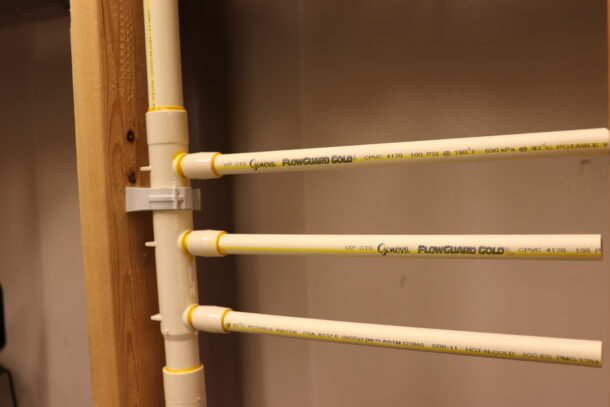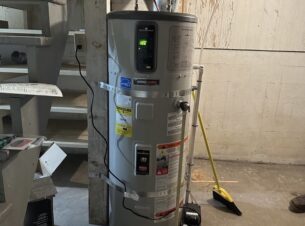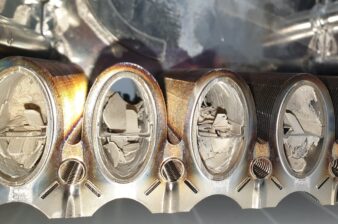CPVC is the only residential plumbing material that is immune to degradation or corrosion from exposure to chlorinated drinking water. CPVC is even unaffected by drinking water treated with aggressive methods that can increase the likelihood of premature failure in PEX and copper systems such as chlorine dioxide and chloramines. That means CPVC failures can almost always be traced to one of two causes: installation error or exposure to incompatible chemicals.
The Solvent Weld Process for Copper Tube Size CPVC
CPVC uses a solvent weld process to permanently weld fittings to pipes. When the process is performed properly, the pipe and fitting are fused into a single piece that creates a joint that is stronger than the pipe or fitting on their own. For plumbers who work with CPVC regularly, the solvent weld process gets to be second nature. But if you are new to CPVC, here are a few tips to keep in mind when using solvent cement. The tips provided are specific to Copper Tube Size CPVC (which is typically tan in color) and may not apply to IPS Schedule 80 CPVC (which is typically gray in color). Always consult your manufacturer for specific installation instructions.
- Use the right cement: Copper Tube Size CPVC can use one-step cement, such as FlowGuard® Gold 1-Step Yellow or new High Contrast Green Cement. The use of green solvent cement with CPVC was added to the 2024 codes of all major bodies to make it easier to visually inspect an installation.Because service plumbers often need to make repairs quickly and get to the next job, a specially formulated solvent cement, Oatey® Orange Lava, was developed. It enables one-step cure times as fast as 15 minutes for cold water lines. Always verify code requirements and follow the solvent cement manufacturer’s recommendations for cure times and installation procedures.
- Cut square and chamfer: Before applying solvent cement, the pipe should be cut square, and any tailings and bevel on the pipe end removed by chamfering.
- Avoid dry fits: A dry fit is simply putting a pipe and fitting together without applying solvent cement. This approach can increase the likelihood one or more fittings will not be solvent welded. Welding the system joint by joint is a better practice. You should check the fit of the pipe before assembling the joint. Without solvent cement, the pipe should fit tightly inside the fitting without bottoming out.
- Apply the right amount of cement: A good practice is to apply a heavy, even coat of one-step solvent cement to the outside of the pipe end. Then, using the same applicator without additional cement, apply a thin coat inside the fitting socket. Excess cement should not be allowed to puddle in the fitting assembly.
- Bottom out the pipe in the fitting: The more surface area of pipe that contacts the fitting, the stronger the bond. After the cement has been applied, the pipe should be inserted until it bottoms out against the fitting.
- Watch extreme temperatures: According to manufacturers of one-step CPVC solvent cement, the cement works best in temperatures between 40° F and 110° F. Outside that range, special precautions should be taken. Cements will cure more quickly in high temperatures and more slowly in cold temperatures. Check the can of solvent cement for proper working temperatures.

Expansion and Contraction
All piping materials will expand and contract based on differences between the installation and operating temperature of the system and changes in the temperature of the water flowing through the pipe. FlowGuard Gold CPVC can expand about 1 inch per 50 feet of straight length of pipe per 50°F temperature increase. If expansion and contraction aren’t accounted for in installation, the stress caused by this expansion can rise to 1200 psi. Because of CPVC’s incredible strength, this may not cause immediate failure in the system, but long-term exposure to these extreme stresses can cause failures after years in service.
In many cases, normal changes of direction can be enough to account for expansion and contraction provided the natural movement of the pipe is not restricted and there is adequate spacing between elbows and hangers. Overtightening pipe hangers may also restrict lateral movement of the pipe. For long, straight runs, loops or offsets can be used. If you have any questions, consult the manufacturer’s installation guidelines.
Chemical Incompatibility
If properly installed CPVC pipe experiences a failure, the likely culprit is contact with incompatible chemicals. Depending on the type and amount of incompatible chemical a pipe is exposed to, the failure may happen quickly or could take years to develop. For example, CPVC can be softened over time by the plasticizers contained in some rubbers and flexible vinyl products, so these materials should be prevented from contacting the pipe or fitting.
Service plumbers are most likely to encounter chemical incompatibility under sinks where the pipe can be exposed to surfactant chemicals found in some household cleaners. In these situations, a CPVC-to-copper stub-out should be used instead of stubbing out with a length of CPVC pipe.
The FBC™ System Compatible Program can be used to identify materials that are compatible and incompatible with FlowGuard Gold, BlazeMaster and Corzan CPVC. For other brands of CPVC piping, consult with the specific manufacturer(s) for compatibility information.

Handling Aged Pipe
As it ages, CPVC naturally becomes more rigid and may even show signs of discoloration. These changes do not reduce the expected service life of the pipe when properly installed. In fact, the pressure-bearing capability of CPVC pipes actually increases with age. But aged pipe should be handled and cut differently than new pipe. A C-style tubing cutter, fine-tooth saw or wheel cutter should be used when servicing CPVC. Ratchet cutters or shears are generally not recommended.
The Professional Plumber’s Choice
Professional plumbers appreciate CPVC because it is easy to work with and results in a clean, professional installation that highlights the plumber’s craftmanship and commitment to quality. For more information on CPVC, including step-by-step installation instructions and other resources, visit flowguardgold.com.
 Jonathan Simon is the North American residential plumbing manager for Lubrizol Advanced Materials Inc., the parent company for FlowGuard Gold Pipe and Fittings.
Jonathan Simon is the North American residential plumbing manager for Lubrizol Advanced Materials Inc., the parent company for FlowGuard Gold Pipe and Fittings.




Join the conversation: